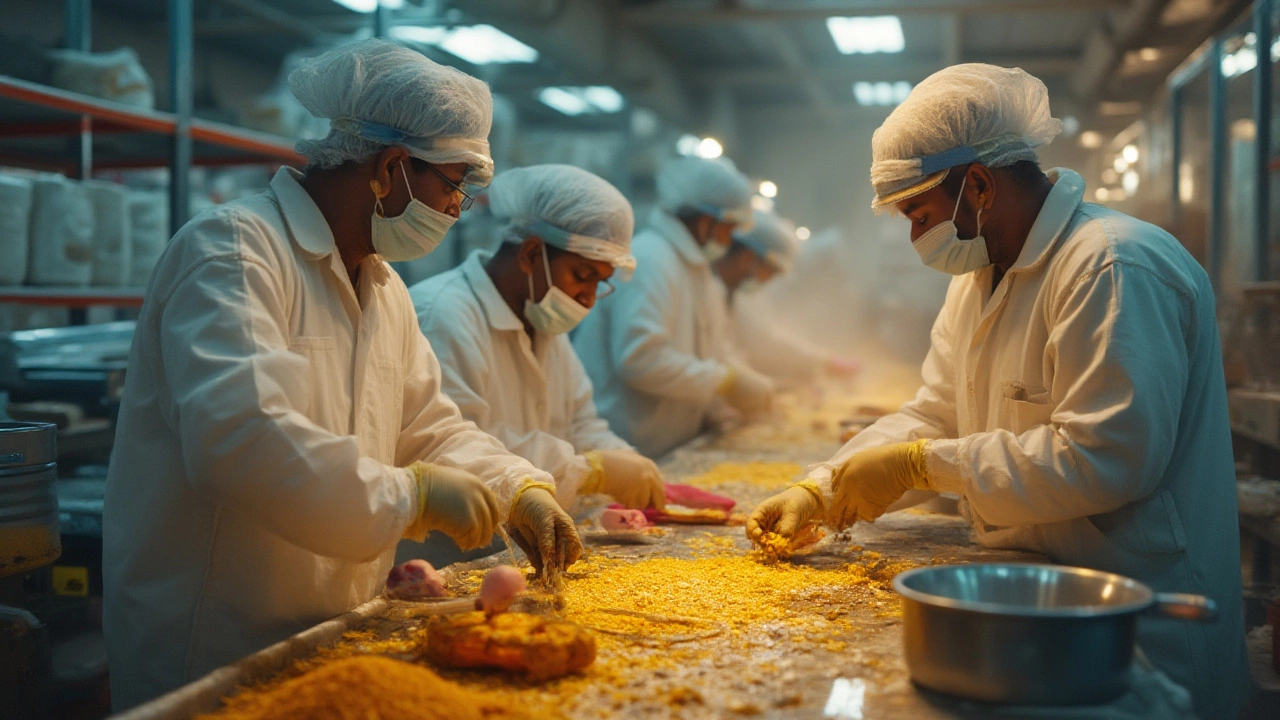 Jul, 26 2025
Jul, 26 2025
Ever notice how ‘one size fits all’ just doesn’t work when it comes to food? Walk into a modern food processing plant and you’ll see a maze of containers, conveyors, and clever designs—all built to move and measure what we eat. Here’s the catch: every tomato, chicken nugget, or scoop of flour needs to be tracked, measured, and processed somewhere along the way. But how does a factory turn those random piles of ingredients into neatly packed, exactly portioned meals or snacks? That’s where ‘food units’ step in, silently running the show behind every can, packet, or snack bar you eat.
What Are Food Units and Why Do They Matter?
Let’s start with the basics. When you hear “food units,” you might think it’s just about counting apples or weighing pasta. That’s part of it, but the truth is a lot more interesting. In food manufacturing and processing, a ‘food unit’ is any measurable chunk, portion, or package of food that’s used to set up recipes, track inventory, calculate nutrition, keep costs in line, or meet food safety rules. These units let plants handle huge volumes without chaos. Each food unit could be a kilogram of flour, a single egg, a case of yogurt cups, or even a batch as defined by a production recipe.
Food units aren’t just about math—they’re about precision and trust. Consider this: The World Health Organization says that up to 10% of the world’s population gets sick each year due to contaminated food. One sneaky mix-up with measurements (like a missing ‘unit’ of preservative or extra grams of peanut) can risk millions of lives. That’s why top manufacturers create super-specific systems to label, count, and track every food unit, from raw potato to chip bag.
In fact, food units are so tightly controlled that in Europe, everything from a cup of fruit yogurt to a sack of wheat must match standardized units set by organizations like the European Committee for Standardization (CEN). This is what makes it easier to ship foods across borders, compare prices globally, and slap on those labels you skim in the supermarket. Try to make sense of calories or allergens without those units—it’s chaos.
An example? When my son Asher and I make brownies, I might toss in a ‘handful’ of chocolate chips, but at a factory, recipes specify 250 grams per tray, not a random scoop. That level of accuracy isn’t just nice to have—it’s critical for every large-scale operation so your favorite treat tastes (and costs) the same every time.
The FDA sets different food unit standards for labeling, like serving sizes you see on the back of meal kits and snacks. Manufacturers have to follow those units strictly or risk fines, product recalls, and even lawsuits. One famous case in 2015 saw a US bakery recall over 30,000 pounds of bread because the slices were a tiny bit larger than stated per unit. Imagine all that bread, wasted, because a machine sliced extra 2 grams per piece.
Types of Food Units in Modern Food Processing
Dive inside a food factory and you’ll run into several ways to slice and dice ‘food units.’ Each serves a purpose—and some are more surprising than you’d think:
- Weight-based units—grams, kilograms, ounces, pounds. Are the go-tos for dry goods (like flour, sugar, rice) and meats. Standardized scales take in bulk shipments then spit out precise batch weights for recipes and packaging.
- Volume-based units—liters, milliliters, cups, gallons. Perfect for liquids (think milk, oil, syrups), or for mixing sauces in huge tanks. Some factories use automated pumps that fill bottles to within a fraction of a milliliter, all tracked automatically.
- Count-based units—pieces, servings, or even molecular ‘units’ (like cells for fermentation companies). If you’ve seen a bag marked “18 cookies,” those cookies are the count-based unit and must match what’s printed on the outside.
- Batch or lot units—these group ingredients or finished foods that are made together in one go (like a ‘batch’ of soup or a ‘lot’ of yogurt). This helps with inventory, recalls, and consistency. If one batch has a problem, the whole lot can be traced and fixed quickly.
Which type gets used depends not just on the food itself, but the regulations and the final packaging. If you ever see weird serving sizes (like 2.3 pieces!) on labels, blame the way regulatory food units clash with marketing or packaging sizes. The whole game is about balancing what’s accurate, what works in the factory, and what makes sense to consumers at home.
Take a look at how some standard units stack up for different foods:
| Food Item | Standard Unit (EU) | Standard Unit (US) |
|---|---|---|
| Flour | Kilogram | Pound |
| Milk | Litre | Gallon |
| Bread Loaf | 400 grams | 1 pound (~454g) |
| Eggs | Piece | Piece |
| Canned Tuna | Gram (drained weight) | Ounce (drained weight) |
Those small differences matter a lot when shipping or selling internationally—swap out the wrong food unit and suddenly your lasagna weighs twice what it should, or your snack pack feels mysteriously light.

Why Food Units Are Essential for Food Safety and Quality
If you’ve ever had food poisoning, you know how awful even a tiny mistake can be. Food units sit right at the heart of food safety. Accurate measurement isn’t just a bean-counter’s obsession; it’s how companies avoid contamination, control allergens, and keep every burger patty or pizza slice safe to eat.
The true power of food units is seen in the world of food safety. Take allergens: labeling rules for peanuts, gluten, soy, or milk come straight from the precise definition of a food unit. A single kernel of peanut in the wrong batch can trigger full-scale alarms and force a recall. Every step—from receiving raw ingredients, to mixing, cooking, packing, and labeling—uses their own unit standards, cross-checked and logged for traceability. Supermarkets pull whole lots off the shelves if there’s any slip.
Foodborne illness outbreaks nearly always begin with small deviations in these units, where someone measured a cleaning fluid wrong, or missed a sanitation step in just one unit batch. In 2022, the CDC found that over 80% of U.S. recalls could be tied to mistakes in managing or labeling food units—usually undeclared allergens, undercooked product, or mislabelled weights on packaging.
Quality goes hand in hand with safety. Think about the taste and texture of your favorite granola bar. If every bar in a box is the same unit, you know what you’re getting. Switch up the unit, and suddenly some bars are dry and some are soggy. Manufacturers use high-tech checkweighers and vision systems to inspect each unit flying along a conveyor belt, automatically rejecting anything that’s odd-sized or underweight.
Chasing consistency is what makes factory foods taste the same in Boston and Berlin. “Food units are the backbone of automation and quality control in the food industry,” says Dr. Ellen Peers, food safety consultant.
“Mistakes in unit measurement are almost always at the root of major quality failures—get those right, and you avoid 99% of the biggest problems in food production.”
But there are quirks and hurdles too. Sometimes, foods don’t fit neatly into a single unit—think ‘bunch’ of grapes or ‘clump’ of kale. That’s where flexibility and good record-keeping come in. Smart manufacturers set ‘tolerances,’ or allowed wiggle room, for natural ingredients that just refuse to be identical.
As food gets more complicated—plant-based meats, blended drinks, high-protein snacks—the demand for accurate food units is growing. New sensors and AI systems are being rolled out by big names like Nestlé and PepsiCo to put better eyes on units as they zip through factories at lightning speed, catching problems before they hit the store shelves.
Tips and Insights: How Food Units Shape Everyday Decisions
So, how can you use all this in day-to-day business or even in your own kitchen? A bit of ‘food units’ discipline can save cash, reduce waste, and cut back on food safety risks—no giant factory required.
- Set your own units at home—Tired of guessing how much pasta to boil or chicken to fry? Pick a standard unit (like 100 grams or one cup) for each ingredient you buy in bulk. This makes recipes reliable, and leftovers easier to portion and store.
- Monitor units for budgeting—Restaurants and meal kit companies watch food units to keep menus profitable. Switching from buying whole fish to fillets may save labor, but it can hike costs per unit. Track changes on a simple spreadsheet or app.
- Food waste—A staggering 931 million tons of food is wasted every year (UN, 2021). Most of that comes from portioning errors, overestimating sale units, or kitchen slip-ups. Fine-tune your shopping to match real units used, not just what ‘looks right’ on the shelf.
- Label reading—Don’t let sneaky serving sizes trick you: check grams or milliliters instead of ‘per serving’ to compare foods easily. Some energy drinks or cereals fudge the units to seem healthier on paper—look at the actual food unit, not just the numbers.
- Tech is your friend—Smart scales and kitchen gadgets are more affordable than ever. They help you measure units for recipes, meal prep, or packaging for sales, and keep your diet, budget, and kitchen waste in line.
Food manufacturers keep finding new ways to fine-tune, automate, and standardize food units. Some companies are experimenting with dynamic units—where the packaging adapts based on seasonal ingredients, meaning extra strawberries in summer and extra apple in fall. The next time you unwrap a snack, pour a drink, or even grab a handful of pretzels, you're seeing food units at work—making every bite count as planned.
Once you get the hang of it, you'll spot food units everywhere, from factory floors to the lunchbox snack your kid takes to school. They're the unseen gears that keep our modern food world humming along, serving up safety, savings, and—if you know how to use them—some pretty sweet kitchen wins, too.